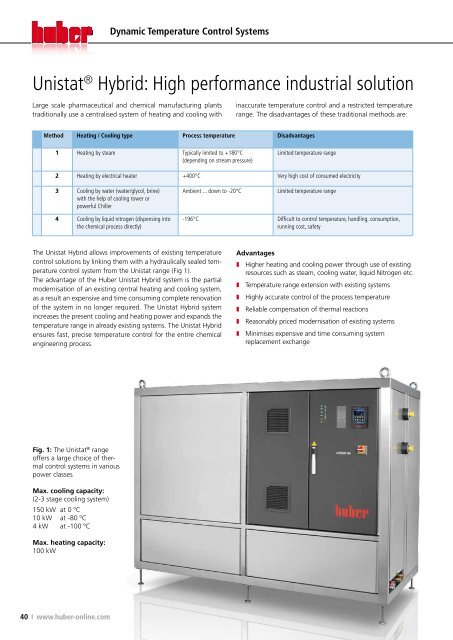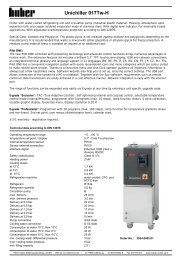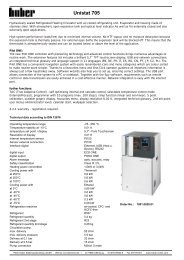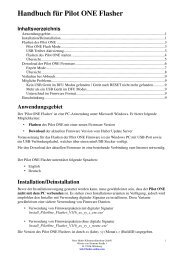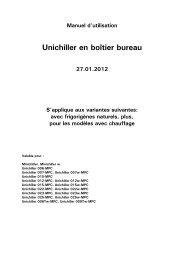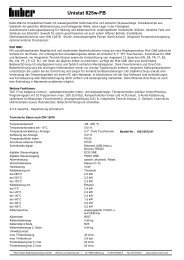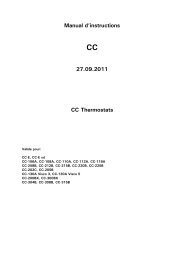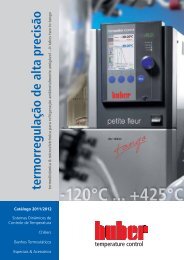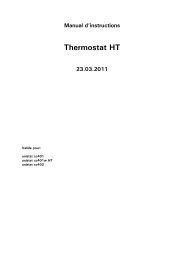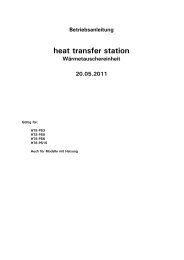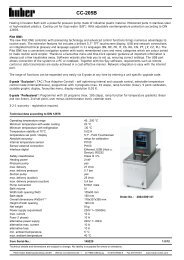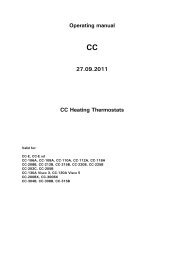VPC - HUBER
VPC - HUBER
VPC - HUBER
Create successful ePaper yourself
Turn your PDF publications into a flip-book with our unique Google optimized e-Paper software.
Unistat ® Hybrid: High performance industrial solution<br />
Large scale pharmaceutical and chemical manufacturing plants<br />
traditionally use a centralised system of heating and cooling with<br />
The Unistat Hybrid allows improvements of existing temperature<br />
control solutions by linking them with a hydraulically sealed temperature<br />
control system from the Unistat range (Fig 1).<br />
The advantage of the Huber Unistat Hybrid system is the partial<br />
modernisation of an existing central heating and cooling system,<br />
as a result an expensive and time consuming complete renovation<br />
of the system in no longer required. The Unistat Hybrid system<br />
increases the present cooling and heating power and expands the<br />
temperature range in already existing systems. The Unistat Hybrid<br />
ensures fast, precise temperature control for the entire chemical<br />
engineering process.<br />
Fig. 1: The Unistat ® range<br />
offers a large choice of thermal<br />
control systems in various<br />
power classes<br />
Max. cooling capacity:<br />
(2-3 stage cooling system)<br />
150 kW at 0 ºC<br />
10 kW at -80 ºC<br />
4 kW at -100 ºC<br />
Max. heating capacity:<br />
100 kW<br />
40 www.huber-online.com<br />
Dynamic Temperature Control Systems<br />
Method Heating / Cooling type Process temperature Disadvantages<br />
1 Heating by steam Typically limited to +180°C<br />
(depending on stream pressure)<br />
inaccurate temperature control and a restricted temperature<br />
range. The disadvantages of these traditional methods are:<br />
Limited temperature range<br />
2 Heating by electrical heater +400°C Very high cost of consumed electricity<br />
3 Cooling by water (water/glycol, brine)<br />
with the help of cooling tower or<br />
powerful Chiller<br />
4 Cooling by liquid nitrogen (dispensing into<br />
the chemical process directly)<br />
Ambient ... down to -20°C Limited temperature range<br />
-196°C Difficult to control temperature, handling, consumption,<br />
running cost, safety<br />
Advantages<br />
K Higher heating and cooling power through use of existing<br />
resources such as steam, cooling water, liquid Nitrogen etc.<br />
K Temperature range extension with existing systems<br />
K Highly accurate control of the process temperature<br />
K Reliable compensation of thermal reactions<br />
K Reasonably priced modernisation of existing systems<br />
K Minimises expensive and time consuming system<br />
replacement exchange


